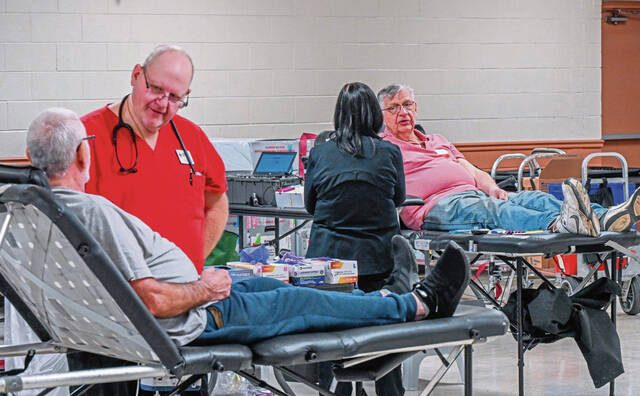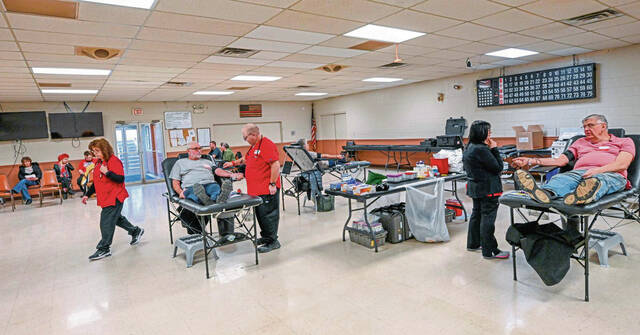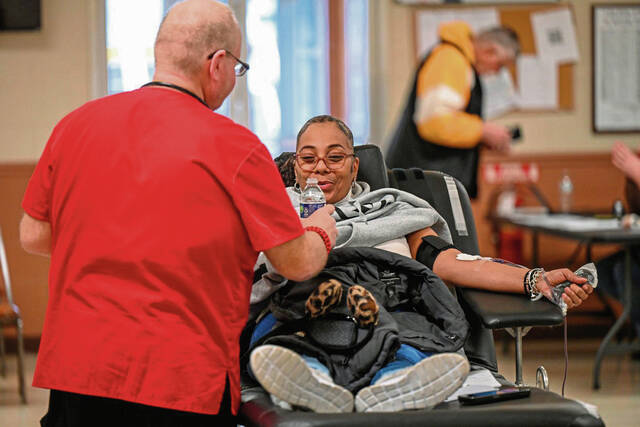Donors needed to give blood as supply falls to critically low levels
Randy Beatty had a good reason to donate blood for the first time in the 1980s.
His grandfather needed it, and Beatty, of Parks Township, wanted to be the one to help.
Since that day, he has tried to donate blood as often as he can.
“You never know when somebody’s going to need it,” he said.
While Beatty and most of the others who gave blood recently at the Gilpin Township Volunteer Fire Department have donated blood many times, the total number of people giving blood to the Red Cross has fallen by about 40% over the past two decades.
“The pandemic really did have a big impact, but that is just one part of this trend we’ve noticed in the past 20 years,” said Nicole Roschella, Red Cross spokeswoman.
The shortfall can have a huge impact on the availability of blood products, which could lead to delays in medical procedures.
Blood products are going to hospitals faster than donations are coming in, and the Red Cross has had to limit distributions of Type O — the most common blood type — to hospitals, Roschella said.
“It could have a real impact on patient care,” she said.
Vitalant locations in the Pittsburgh area also have experienced a decrease in blood donations, said spokeswoman Kristen Lane. For the past 15 years, the number of people donating blood has dwindled.
“While many activities have resumed pre-pandemic levels, blood donation is not among them,” she said. “The number of people donating blood with Vitalant has dropped 20% since 2019.”
Blood drives also have taken a 50% hit, as remote work continues to be prevalent, Lane said.
Vitalant needs to collect 600 blood donations every day but is receiving only about one-third of that, Lane said.
Vitalant is the exclusive blood provider to Allegheny Health Network and UPMC hospitals.
“Daily personal emergencies and ongoing medical needs of thousands of patients require a constant and ready blood supply,” Lane said. “It’s the blood already at the hospital that saves lives.”
Every day, Lane said, patients in U.S. hospitals, surgical centers and emergency treatment facilities need about 29,000 units of red blood cells, 5,000 units of platelets and 6,500 units of plasma.
“While most of the population is eligible to give blood, only about 3% actually donates,” she said.
Red Cross is working to educate people on the process of giving blood, Roschella said.
The whole appointment lasts just under an hour, and the time someone is actively giving blood takes about 10 minutes, she said.
Common myths people have about giving blood are that it’s unsafe or makes people weaker, Lane said.
Strict safety procedures and sterile, single-use equipment ensure blood donation carries no risk of contracting blood-borne illness, according to Vitalant. The human body contains enough blood to enable someone to donate with minimal or no side effects.
Beatty found the process of giving blood simple and straightforward. So did Patty Rusz of Apollo, who also has been donating blood since the 1980s.
“It’s another way to give back to the community,” she said.
Roschella said blood collected by the Red Cross goes to a processing center in Johnstown and then is distributed to where it is needed. A Red Cross blood donor app tells patients where their blood went.
A Penn State study last year found that if people are told how and where their blood donation will be used, they are more likely to donate again.
Margee Wilkerson of Parks Township has a sickle cell trait, so the blood she donates can help people with sickle cell anemia.
“That’s why I donate,” she said.
Kellen Stepler is a TribLive reporter covering the Allegheny Valley and Burrell school districts and surrounding areas. He joined the Trib in April 2023. He can be reached at kstepler@triblive.com.
Remove the ads from your TribLIVE reading experience but still support the journalists who create the content with TribLIVE Ad-Free.



